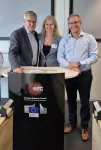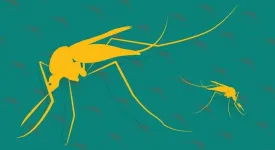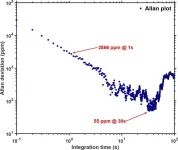(Press-News.org) Considered one of the fastest-growing agricultural frontiers in Brazil, and the area with the highest greenhouse gas emissions in the Cerrado, Brazil’s savanna-type biome, the region known as MATOPIBA risks facing water shortages in the years ahead. Water overuse may mean that between 30% and 40% of demand for crop irrigation cannot be met in the period 2025-40. MATOPIBA is a portmanteau of the names of four states – Maranhão, Tocantins, Piauí, and Bahia (all but Tocantins located in Brazil’s Northeast region).
According to a new study by Brazilian researchers, water overuse and the impact of climate change are reducing groundwater flows from the Urucuia aquifer as well as the surface water bodies of the Grande River basin (the Grande is a tributary of the São Francisco, the largest river in Brazil’s Northeast). The reduction in these flows may lead to water shortages for the towns and cities of the region, for river dwellers, and for farmers throughout the basin. Moreover, agricultural expansion will raise energy requirements for irrigation by up to 40%, posing a developmental challenge due to significant pressure on the water-energy nexus, as hydropower accounts for most of Brazil’s energy mix.
The study was conducted by scientists at Brazil’s National Space Research Institute (INPE) to assess the long-term sustainability of agricultural expansion in the region in the context of worsening water scarcity. An article about it is published in the journal Ambio. The last author is Ana Paula Aguiar, a researcher in INPE’s Impacts, Adaptation and Vulnerability Division (DIIAV). Several of her co-authors are affiliated with Stockholm University’s Stockholm Resilience Center in Sweden.
The MATOPIBA region is mostly in the Cerrado (91% or 665,000 km²), with comparatively minor portions belonging to the Amazon (7.3%) and Caatinga (1.7%) biomes. Its southeastern part is watered by the Grande River basin, which covers some 76,000 km².
The main approach used in the paper is system dynamics, in which feedback control theory serves as a basis for modeling complex interactions between land use, energy and water, and for simulating different scenarios to predict responses over time, as a contribution to decision-making and more effective public policy formulation.
“System dynamics is holistic in the sense that it simulates correlations among demand variables that exist simultaneously in the region, such as irrigation, electricity and consumption. This isn’t always considered in analyses performed by public bodies,” said Celso von Randow, head of INPE-DIIAV and a co-author of the article.
The study was part of the project Nexus – Paths to Sustainability, led by Jean Ometto, a co-author of the article, a senior researcher at INPE, and a member of the steering committee for FAPESP’s Research Program on Global Climate Change (RPGCC).
The purpose of the project was to propose strategies for the transition to a sustainable future in the Cerrado and Caatinga biomes via a participatory approach that integrates qualitative and quantitative methods.
A report on the Nexus project was issued in October with information on the research conducted by the group and other work done on the region. The report was presented to a seminar on “Contributions by the Brazilian scientific community to the discussion on combating desertification” held by SUDENE, a federal agency in charge of development in the Northeast region. Members of the research group will take part in the Brazilian delegation to the 16th Conference of the Parties to the United Nations Convention to Combat Desertification (UNCCD COP16), which is due to be held in Saudi Arabia in December.
“The idea of the study arose during a Nexus workshop in Barreiras [Bahia state]. People had expressed concerns regarding the sustainability of the irrigation system. We developed a system dynamics model for the region, but it can be applied to other areas by adapting a few variables as needed,” agricultural engineer Minella Alves Martins, first author of the article, told Agência FAPESP. She is a postdoctoral researcher at INPE supervised by Randow with support from FAPESP.
The workshop discussed the main challenges relating to water quality and quantity in the Grande River basin, as well as the social and environmental conflicts arising from water use and irregular land tenure. More than 90% of water withdrawals in the basin are for irrigation, according to the National Water and Basic Sanitation Agency (ANA).
Production of grain crops in the MATOPIBA region (337 municipalities) has risen 92% in the last ten years, from 18 million metric tons in 2013-14 to about 35 million mt in the last crop year. In Bahia, the main crops are soybeans, corn and cotton, and the municipality of Barreiras is one of the leading producers in the state.
Production of grain crops in the region is projected to grow 37% in the next decade, reaching 48 million mt in a planted area of 110,000 km².
These numbers are from the study Projeções do Agronegócio, produced by the Ministry of Agriculture in partnership with the Brazilian Agricultural Research Corporation (EMBRAPA).
On the other hand, the severe drought in much of Brazil has lowered the 2023-24 grain crop forecast, especially for MATOPIBA. To make matters worse, the Cerrado has seen a record number of wildfires this year: the total in the first nine months reached 68,868, more than in any year since 2015.
According to the Amazon Environmental Research Institute (IPAM), 80% of the 135 million tons of CO2 released into the atmosphere by deforestation in the Cerrado between January 2023 and July 2024 came from MATOPIBA.
Destruction of native vegetation by fire and deforestation for land use change reduce evapotranspiration by plants, leading to a fall in the amount of rain. Moreover, without plant cover, rain hits the ground harder and faster, flowing away on the surface instead of forming underground channels.
Projections
The system dynamics model used by the researchers showed that surface runoff and groundwater flows will tend to diminish until 2040. They took into account current land uses, climate change and economic feedbacks. Meanwhile, demand for water will grow, mainly owing to the expansion of irrigation, rising from 1.53 m³/s in 2011-20 to 2.18 m³/s in 2031-2040.
As a result, they concluded, irrigated agriculture in the region is likely to stop expanding, and its long-term sustainability in the Grande River basin is uncertain. “Many people in the region told us that water withdrawals are exceeding permitted levels. Our first recommendation is therefore that water use permits should be revised so that they can be aligned with the new climate normal we’re experiencing. The statistics in the time series may be lagging behind, and this could be one reason why permitted levels are too high. Our analysis of data from water well monitoring by CPRM [the Geological Survey of Brazil, an arm of the Ministry of Mines and Energy] showed that groundwater levels are falling, but this system is still used a great deal, and another recommendation is therefore that law enforcement should be stepped up so as to ban clandestine wells and ensure rational use of water resources when new wells are sunk,” Martins said.
The group also recommends tighter control of changes in land use and land cover in order to prevent impairment of aquifer recharging and foster more efficient and rational strategies of water use in agriculture. For future studies, the scientists suggest exploration of other forms of adaptation to the new conditions, such as connecting the local electricity subsystem to the national grid and creating additional channels to ensure supply.
About São Paulo Research Foundation (FAPESP)
The São Paulo Research Foundation (FAPESP) is a public institution with the mission of supporting scientific research in all fields of knowledge by awarding scholarships, fellowships and grants to investigators linked with higher education and research institutions in the State of São Paulo, Brazil. FAPESP is aware that the very best research can only be done by working with the best researchers internationally. Therefore, it has established partnerships with funding agencies, higher education, private companies, and research organizations in other countries known for the quality of their research and has been encouraging scientists funded by its grants to further develop their international collaboration. You can learn more about FAPESP at www.fapesp.br/en and visit FAPESP news agency at www.agencia.fapesp.br/en to keep updated with the latest scientific breakthroughs FAPESP helps achieve through its many programs, awards and research centers. You may also subscribe to FAPESP news agency at http://agencia.fapesp.br/subscribe.
END
Water overuse in MATOPIBA could mean failure to meet up to 40% of local demand for crop irrigation
Overuse of water resources in Brazil’s main agricultural frontier region, in conjunction with climate change, is reducing replenishment of the Urucuia aquifer and surface water bodies in the basin of a tributary of the São Francisco.
2024-11-05
ELSE PRESS RELEASES FROM THIS DATE:
An extra year of education does not protect against brain aging
2024-11-05
Thanks to a 'natural experiment' involving 30,000 people, researchers at Radboud university medical center were able to determine very precisely what an extra year of education does to the brain in the long term. To their surprise, they found no effect on brain structure and no protective benefit of additional education against brain aging.
It is well-known that education has many positive effects. People who spend more time in school are generally healthier, smarter, and have better jobs and higher incomes than those with less education. However, whether prolonged education actually causes changes in brain structure over the long term ...
Researchers from Uppsala and Magdeburg obtain an ERC Synergy Grant to advance cancer immunotherapy
2024-11-05
Targeting and customizing blood vessels in tumors to increase T cell infiltration and maintain their function may represent the next breakthrough in cancer therapy. The European Research Council has recognized this by awarding a prestigious Synergy Grant to the project VASC-IMMUNE, where three researchers, each possessing complementary expertise in this research topic, will synergize to advance the field. Professors Anna Dimberg and Magnus Essand are both from the Department of Immunology, Genetics and Pathology, Uppsala University and Professor Thomas Tüting is from the Department of Dermatology, University Hospital Magdeburg.
The successful implementation ...
Deaf male mosquitoes don’t mate
2024-11-05
Mosquitoes are much more blunt. Mating occurs for a few seconds in midair. And all it takes to woo a male is the sound of a female’s wingbeats. Imagine researchers’ surprise when a single change completely killed the mosquitoes’ libidos.
Now a study out of UC Santa Barbara reveals that this is really all there is to it. Researchers in Professor Craig Montell’s lab created deaf mosquitoes and found that the males had absolutely no interest in mating. “You could leave them together with the females ...
Recognizing traumatic brain injury as a chronic condition fosters better care over the survivor’s lifetime
2024-11-05
INDIANAPOLIS – A commentary, published in the Journal of Neurotrauma, calls for traumatic brain injury to be recognized as a chronic condition as are diabetes, asthma, depression and heart failure.
To provide comprehensive care for traumatic brain injury throughout individuals’ lifespans, the authors propose that coordinated care models they and others have developed, tested and applied to various populations -- including older adults, individuals living with depression and post-intensive care unit survivors -- be adapted to improve communication and integration between brain injury specialists -- including ...
SwRI’s Dr. James Walker receives Distinguished Scientist Award from Hypervelocity Impact Society
2024-11-05
SAN ANTONIO — November 5, 2024 —Southwest Research Institute’s Dr. James Walker has received the Distinguished Scientist Award from the Hypervelocity Impact Society. This honor recognizes individuals who have made a significant and lasting contribution to the field of hypervelocity science. Hypervelocity impact is typically viewed as impacts at speeds above 2 kilometers per second (4,475 miles per hour); for some materials, however, lower speed impacts display hypervelocity impact effects.
The ...
A mother’s health problems pose a risk to her children
2024-11-05
Women with polycystic ovary syndrome (PCOS) and obesity are at a higher risk of giving birth to smaller babies in terms of birth weight, length, and head circumference, according to a recent study conducted at the Norwegian University of Science and Technology (NTNU).
One in eight women is affected by the hormone disorder PCOS. Common characteristics are elevated levels of male sex hormones, infrequent or irregular menstrual periods, and the formation of small cysts on the ovaries.
In the study, 390 children born to women ...
Ensuring a bright future for diamond electronics and sensors
2024-11-05
Researchers are developing new ideas about the best ways to make lab-grown diamonds while minimizing other forms of carbon, such as soot. These diamonds aren’t destined for rings and necklaces, though. These are the kinds that are needed for the computers, optics and sensors of the future.
One new study, conducted by researchers at the U.S. Department of Energy’s (DOE) Princeton Plasma Physics Laboratory (PPPL) and Princeton University, investigated ways to reliably grow diamond at lower temperatures than those currently used. Diamond has properties ...
The American Pediatric Society selects Dr. Maria Trent as the Recipient of the 2025 David G. Nichols Health Equity Award
2024-11-05
The American Pediatric Society (APS) is pleased to announce Maria E. Trent, MD, MPH, as the 2025 David G. Nichols Health Equity Award recipient.
The David G. Nichols Health Equity Award, administered by the APS and endowed by the American Board of Pediatrics (ABP) Foundation, was created to recognize demonstrated excellence in advancing child and adolescent health, well-being, and equity through quality improvement, advocacy, practice, or research. This award recognizes Dr. Trent’s outstanding contributions to advancing child and adolescent health, well-being, and equity and the far-reaching impact of her work. The award will be presented to Dr. Trent ...
The first 3D view of the formation and evolution of globular clusters
2024-11-05
A study published today in Astronomy & Astrophysics marks a significant milestone in our understanding of the formation and dynamical evolution of multiple stellar populations in globular clusters (spherical and very compact stellar agglomerates typically populated by 1–2 million stars). This pioneering study, conducted by a group of researchers from the National Institute for Astrophysics (INAF), the University of Bologna, and Indiana University, is the first to perform a 3D kinematic analysis of multiple stellar populations for a representative sample of 16 globular clusters in our Galaxy. It provides ...
Towards a hydrogen-powered future: highly sensitive hydrogen detection system
2024-11-05
Hydrogen gas is a promising energy source with several advantages - it is lightweight, storable, energy-dense, and environmentally friendly compared to fossil fuels, producing no pollutants or greenhouse gas emissions. As such, it has extensive applications across different fields, including transportation, architecture, power generation, and industries. However, hydrogen is highly flammable, and therefore its safe and widespread use requires reliable methods for detecting leaks and ensuring its purity. The need for reliable detection methods has necessitated the development of trace-gas sensing techniques. While several methods have been developed for hydrogen sensing, ...
LAST 30 PRESS RELEASES:
Interaction of climate change and human activity and its impact on plant diversity in Qinghai-Tibet plateau
From addressing uncertainty to national strategy: an interpretation of Professor Lim Siong Guan’s views
Clinical trials on AI language model use in digestive healthcare
Scientists improve robotic visual–inertial trajectory localization accuracy using cross-modal interaction and selection techniques
Correlation between cancer cachexia and immune-related adverse events in HCC
Human adipose tissue: a new source for functional organoids
Metro lines double as freight highways during off-peak hours, Beijing study shows
Biomedical functions and applications of nanomaterials in tumor diagnosis and treatment: perspectives from ophthalmic oncology
3D imaging unveils how passivation improves perovskite solar cell performance
Enriching framework Al sites in 8-membered rings of Cu-SSZ-39 zeolite to enhance low-temperature ammonia selective catalytic reduction performance
AI-powered RNA drug development: a new frontier in therapeutics
Decoupling the HOR enhancement on PtRu: Dynamically matching interfacial water to reaction coordinates
Sulfur isn’t poisonous when it synergistically acts with phosphine in olefins hydroformylation
URI researchers uncover molecular mechanisms behind speciation in corals
Chitin based carbon aerogel offers a cleaner way to store thermal energy
Tracing hidden sources of nitrate pollution in rapidly changing rural urban landscapes
Viruses on plastic pollution may quietly accelerate the spread of antibiotic resistance
Three UH Rainbow Babies & Children’s faculty elected to prestigious American Pediatric Society
Tunnel resilience models unveiled to aid post-earthquake recovery
Satellite communication systems: the future of 5G/6G connectivity
Space computing power networks: a new frontier for satellite technologies
Experiments advance potential of protein that makes hydrogen sulfide as a therapeutic target for Alzheimer’s disease
Examining private equity’s role in fertility care
Current Molecular Pharmacology achieves a landmark: real-time CiteScore advances to 7.2
Skeletal muscle epigenetic clocks developed using postmortem tissue from an Asian population
Estimating unemployment rates with social media data
Climate policies can backfire by eroding “green” values, study finds
Too much screen time too soon? A*STAR study links infant screen exposure to brain changes and teen anxiety
Global psychiatry mourns Professor Dan Stein, visionary who transformed mental health science across Africa and beyond
KIST develops eco-friendly palladium recovery technology to safeguard resource security
[Press-News.org] Water overuse in MATOPIBA could mean failure to meet up to 40% of local demand for crop irrigationOveruse of water resources in Brazil’s main agricultural frontier region, in conjunction with climate change, is reducing replenishment of the Urucuia aquifer and surface water bodies in the basin of a tributary of the São Francisco.







